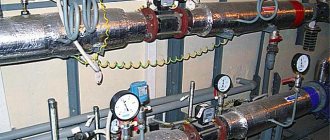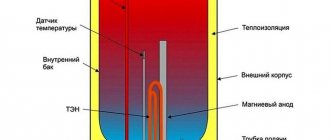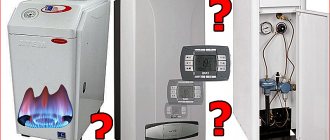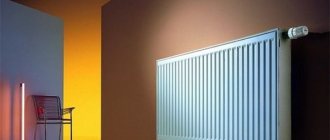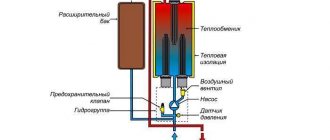Here you will learn how to save on heating in an apartment: an alternative to central heating in an apartment building, additional economical heaters, how to heat a room with a quartz appliance.
What residents of apartment buildings experience when they receive payment receipts at the beginning of the heating season is more like shock than surprise.
The trend of constant upward growth in utility tariffs is causing more and more people to ask the question of how to save on heating in an apartment.
Unfortunately, residents of high-rise buildings have a limited choice, but they still have it.
How much does a heat meter help you save?
If the heating system of a high-rise building allows the installation of heat meters, then this can be done, but taking into account some nuances:
- If there are uninsulated areas in the apartment and the heat loss is quite large, then the metering device is just a wasted expense. First , you should solve the problem of insulating windows, balconies, doors and walls , and then move on to the issue of saving.
- Residential meters are not always justified, since in addition to the heat consumed by housing, you have to pay for its delivery along the heating main and heating of non-residential premises , for example, staircases. It is cheaper when a common building meter is installed and payment is made based on the consumption of the entire building divided by the number of apartments. This is especially beneficial if the house is warm. This option is more expensive, but it is fully justified, so it makes sense for residents to unite and install a common building meter.
- If the metering device is installed in the apartment and registered with the management organization, you can save by lowering the temperature in your home. To do this, it is enough to reduce the flow of coolant into the apartment, and by lowering the temperature by at least 1 degree, you can save up to 6% of heat.
Economical heating of an apartment with an individual meter is only possible if there is no heat loss in the apartment.
Stationary heat sources for apartments and houses
There are quite a lot of options for heating a room, each of them has its own advantages and disadvantages, but most do not require serious financial investments. Stationary heat sources are good because they do not require constant monitoring of the equipment, and the comfortable temperature does not need to be adjusted.
When living in the private sector, the first thing that comes to mind for heating the room is a stove. The designs are different, they are made of brick, cast iron and steel, so for your home you just need to calculate your budget, which model of heating equipment to choose, taking into account the availability of fuel in the region. In this case, it is necessary to organize a pipe to remove carbon monoxide and constantly clean the firebox if solid fuel is used.
But what should apartment residents do when the temperature in the room is rapidly dropping and this threatens the whole family with illnesses and wrapping children in warm blankets while sleeping.
How to save on heating in an apartment?
Elimination of cold sources
It is very easy to find out where the heat is leaving the apartment:
- The first thing to check is the windows. If they are wooden, then over time the wood dries out and begins to crumble, forming cracks, sometimes not even visible to the eye. The defect may also be located at the junction of the glass and the frame. If it is not possible to change the windows, then you need to use the old fashioned method and cover them with paper. Nowadays, there are special self-adhesives; in extreme cases, adhesive tape will do. When replacing windows with metal-plastic double-glazed windows, you should opt for two-chamber models with glass coated with a special substance. Statistics show that such windows create savings of up to 30%.
- An unglazed balcony is the weakest “link” of the apartment. If possible, it should be insulated and glazed, then it will become a kind of buffer between the street and the apartment.
- The simplest answer to the question of how to save on heating in an apartment building is to insulate the facade. Many modern houses stand out with these “patches” on their walls. It is the residents who insulate the façade with expanded polystyrene at their own expense. This material, only 5 cm thick, retains heat better than brickwork. The same statistics show that such insulation immediately reduces energy costs by 30%. In combination with a glazed balcony and windows, this will significantly reduce heating costs.
Of course, glazing and insulating the facade require large investments, but taking into account the fact that tariffs tend to increase exclusively, such an investment will quickly pay off.
Additional heaters
How to improve heating in an apartment? Today, the construction market offers a large number of heating devices that can serve, if not as an alternative to central heating, then as a support.
Additional heating of the apartment is required if the temperature provided by the heat supplier every winter is not sufficient.
For such cases, the following types of apartment heating devices are suitable:
- The advantage of oil radiators is their low price and the ability to heat a room of up to 18-20 m2 due to the high thermal conductivity of the medium. They are safe, have temperature regulators and can be left “unattended” without fear for the integrity of the apartment. Among the disadvantages of these devices is their long warm-up time and drying out the air.
- If you are concerned about additional heating of your apartment, the most economical way is to purchase a convector heater . It is inexpensive, consumes little electricity, heats up quickly, is lightweight, but is a fire hazard. Such a device cannot be left on unattended.
- Fan heaters can not only be moved from one room to another, but also mounted to the wall or even the ceiling, depending on the model. They are powerful, capable of heating large areas, evenly distributing heated air throughout the room. The disadvantage is drying of the air and noise.
- If you need to heat a non-residential space in an apartment building, then an infrared heater . It does not dry out the air, quickly heats the room, warming up the objects in it, is silent, consumes little energy and is completely safe. The only drawback is the inexpensive Chinese models, which require frequent replacement of lamps.
- a micathermic heater can be an excellent addition, or even a replacement for the main heating. It is based on elements emitting infrared waves, packed in a mica body. It can quickly heat a large room, giving off heat to surrounding objects, it is completely safe, silent, powerful, compact and very expensive.
When thinking about how to save on heating in an apartment building when choosing an additional heater, you should focus not on its cost, but on the amount of energy it requires to operate. If the assistant “eats up” a decent part of the budget in the form of electricity bills, then this can hardly be called savings.
Quartz heaters
These types of heat sources appeared on the market about 10 years ago, but during this time they not only won fans, but also significantly expanded their model range. Natural processes were taken as the basis. Anyone who has ever been to the sea remembers how hot the sand can be when heated by the sun, and how long it takes to cool down in the evening.
Heating an apartment in an apartment building with a quartz heater is becoming increasingly popular due to its technical characteristics:
- It uses a chromium-nickel alloy tube as a heating element, either sealed in a flask or “embedded” in a solid quartz slab.
- A reflective metal plate is installed behind the heater as a diffuser of infrared radiation.
- The built-in thermostat allows you to save up to 40% on space heating costs.
More expensive models are equipped with automation, thanks to which you can set the heating level at different times of the day. Special sensors will prevent the device from overheating.
If someone is concerned about the question of how to heat an apartment in winter without central heating, then a quartz heater may well take on this responsibility.
Only monolithic models are suitable for this role, since their heating elements, which are very sensitive to shock, are built into pressed quartz slabs.
They are not only powerful and can easily heat a room of up to 20 m2 with minimal energy consumption, but they are also completely safe, do not dry out the air and continue to emit heat for a long time even when the electricity is disconnected.
The only drawback of a quartz heater is its price, which is more than compensated by its long service life and low energy consumption. Considering how much centralized heating costs per month today, we can calculate that by purchasing such a device for each room, this will free the consumer for many years from encroachments on his wallet by management companies.
Which heaters heat better?
Are you shivering from the cold in the office, but at home you wrap yourself in a warm blanket and never part with a mug of tea? You need a heater, which has long become an indispensable thing for countries where winter lasts more than 4 months. How to prevent yourself from freezing and choose the best heater?
Why buy a heater?
The “hottest” (in the figurative sense of the word) time, which forms the main demand for the purchase of heaters, is late autumn, when heating has not yet arrived in residential buildings, and the cold has approached the apartments closely. However, if we take into account the work of Russian utilities and climatic conditions, a heater in an apartment can be useful at almost any time of the year. Modern heaters are high-tech, safe devices that can not only heat a room, but also, if they have some functions, humidify the air and even cool it.
What types of heaters are there?
Today, stores offer a wide variety of different heaters and heating systems. Moreover, the devices differ from each other not only in the manufacturer, but also in their design.
Oil filled radiator
One of the most common types of devices in everyday life. According to the principle of its operation, it resembles a conventional central heating battery. The oil cooler is a sealed metal housing filled with mineral oil. It, heated by an electric coil, transfers heat to the metal, which, in turn, heats the room.
An oil radiator consists of several sections (usually from 5 to 15), the number of which directly affects the heat exchange area. The more sections, the less the device heats up, and the less chance of getting a burn when touching it. Oil radiators do not produce noise, do not burn oxygen, are fireproof and have a relatively low price for all their advantages. They can be safely left on overnight. Despite its heavy weight (about 10 kg), the oil radiator remains quite mobile, since it is usually equipped with wheels. However, this type of device takes a long time to warm up to operating temperature - 10-20 minutes.
Test of heaters of famous brands
How to choose heater power?
Having chosen the type of heater you like, you need to pay close attention to its power. To do this, you need to decide which room the device will heat. A medium-power device can warm up a small living room. In a large room it will work hard. This means that optimally selected power will increase the service life of the heater.
There are many tables to calculate the required power in each individual case, but in reality everything depends not so much on the volume of the room, but on its heat loss. It will be difficult to heat even a small room if it is constantly blowing from the window and the walls are cold, since the room is corner.
Just keep in mind that for the average living space up to 10 sq.m. A heater with a power of 1.5 kW (1 kW) is enough . Here and below, the required power for auxiliary heating is indicated in parentheses, while the main power value, which is in front of the brackets, is suitable in the event of a complete shutdown of central heating in the fall and in light frosts. A room with an area of up to 15-20 sq.m. It is better to heat with a model with a power of 2 kW (1.5 kW) , and a room of 25-30 sq.m. do not warm up with a heater weaker than 2.5 kW (2 kW)
Advantages
- Ability to maintain a set temperature for a long time
- Don't burn oxygen
- Relatively low power consumption after reaching operating mode
Flaws
- Large dimensions and only floor placement
- Slow heating of the room
Fan heater
The most budget-friendly type of device, which enjoys stable popularity among consumers. The design of this heater is simple: a heating element is installed in its body, behind or in front of which a fan is located. Working together, they form a stream of hot air that spreads throughout the room.
As a rule, fan heaters are compact, mobile and quickly heat the air. Fan heaters almost always create a noticeable level of noise; the heating element burns oxygen or, at a minimum, greatly dries out the air in the room. Moreover, models with a ceramic heater are compared to budget “breeches” with a wire heater in terms of energy consumption and efficiency. differ very little.
Heating without central heating
How to heat an apartment without heating? Refusal of conventional apartment heating is a pressing problem for many residents of high-rise buildings today. An alternative to central heating in an apartment today is an autonomous heating unit.
A natural obstacle to those who want to provide themselves with heat on their own is centralized heating, or rather its suppliers. The more residents refuse their services, the more expensive they will be for others, and the lower the income of the organization itself. This is why it is so difficult to get permission to waive it, but it is possible and it is legal.
Each consumer must decide how to heat an apartment without heating independently, but they have little choice.
How to heat an apartment without central heating?
Alternative to central heating in an apartment building:
- Any heaters presented on the domestic market - from the cheapest oil radiators to expensive quartz monolithic devices.
- Warm floors , both cable and infrared (no one will give permission for water ones).
- Electric and gas boilers.
Household heaters were mentioned above, and underfloor heating systems have become in great demand in the last 5-10 years. Once upon a time, only very wealthy people could afford them. Today you can easily buy them in a store and even install them yourself.
Their advantages are the creation of the necessary microclimate in the room, low energy consumption and the ability to regulate the quality and quantity of heat. Disadvantages include high price and installation features. For example, cable heated floors are laid in a screed. Another feature is the correct choice of flooring, since not all materials tolerate temperature differences well.
Alternative heating in an apartment based on gas or electric boilers is a profitable investment of money, but not time. It will be necessary to coordinate many issues with a large number of organizations, because this option for heating an apartment is a rather complex structure with a system of pipes and radiators filled with coolant.
Reykjavik, Iceland: Live on a Volcano
The inhabitants of another island, Iceland, have long been accustomed to using hot springs for washing and washing clothes. In 1908, one farmer had the idea to connect a pipe from a hot spring to his house, through which steam would flow to warm the house. In the 1930s, Reykjavík built a three-kilometer pipeline from a large source that heated 60 houses in the city, a hospital and two schools. This was already the prototype of a central heating system.
Today, 90% of homes in Iceland are heated using hot spring water flowing through pipes. In addition, five geothermal power plants with a total capacity of over 800 MW meet 26% of the country's electricity needs. The rest comes from hydropower. Iceland uses virtually no coal or oil.
Central heating
Maybe, before choosing an alternative way to heat your home, it’s worth learning a little more about what you already have and the opportunity to save on it. For example, a heating device for an apartment building with a heat exchanger. With centralized heating of housing, a boiler room is installed for several houses. From it, heat is distributed through pipes into buildings.
If each consumer has a heat exchanger installed in their home, they will be able to influence the quantity and quality of heat in their apartments, provided that their radiators have thermostats.
The quality of the heating system elements plays no less a role than the heat exchanger in the matter of economy. The design of an apartment heating radiator is no exception.
There is a large selection of heating batteries on the domestic market, which differ not only in technical characteristics, but also in the material from which they are made, size and even color.
You can save a lot on heating your home by first investing in new radiators. As practice shows, bimetallic models are in greatest demand, despite the fairly high cost. They are not only durable, safe and beautiful, but also withstand pressure drops of up to 16 atmospheres, are not demanding on the coolant and are very efficient.
Sometimes it is enough to change the batteries in the apartment in order to pay 50% or more less for heating your home in all subsequent years. It is much easier to coordinate such work with the management company than when abandoning centralized heating, and by choosing the best option for radiators, the issue of heating costs will be closed for a long time.
Another type of savings with conventional heating is the transition to horizontal heating in the apartment. The beam system is especially popular among consumers. Not only does it have no drawbacks and provides residents with high-quality heat, but it also looks aesthetically pleasing, since all pipes are retracted into the floor.
Currently, more and more houses with vertical distribution are switching to horizontal collector (radiant) heat supply. This is not cheap, but it allows residents to monitor the quality of home heating and significantly save on heating costs in subsequent years.
You can also significantly reduce heating costs by knowing how to increase the efficiency of the heating battery in your apartment. A good and easy way to do this is to install a screen behind it. They can be foil or any metal plate. You can buy a ready-made screen in a store.
This minor addition will allow the heat to remain in the room rather than escaping into the wall. Moreover, the screen itself, heated by heat from the radiator, begins to transmit it to the room. The savings reach 15%.
In conclusion, we can say that modern residents of apartment buildings have a choice of how to heat their homes, and it is significant. It all depends on the price, desire and amount of time invested in this issue. For some, it is enough to insulate their apartment in order to pay less; for others, they are ready to free themselves from the “bondage” of centralized heating and install an autonomous heat source. Only after studying all the options can you find the best one for yourself.
Reducing heat loss
To avoid suffering from cold in your apartment in the fall, you need to take care in advance to reduce heat loss. Up to 30% of thermal energy is lost through loosely fitting window sashes and doors. Therefore, doors and windows are insulated first. After this, the house will become much warmer.
Modern double-glazed windows, as a rule, provide a high level of tightness. Therefore, there is no need to insulate them additionally. Old wooden frames dry out over time. Large gaps appear in them, through which heat escapes. To seal such window openings, putty, cotton wool, old newspapers, and rags are used.
On a note! To keep warm, you can use plastic film. This material allows sunlight to pass through, but does not allow cold air to penetrate from outside. During the day, it is recommended to open the curtains to let the sun's rays into the room. They will heat the room. At night, the curtains are closed so as not to lose warm air. It is better to use thick and heavy curtains. They provide less heat loss.
When insulating windows, we must not forget about the front door. The door frame is lined with thermal insulation material. An additional insulating layer can be placed in the door leaf. Additionally, it is recommended to install a second door. It will keep the house warm and reduce noise levels.
Another source of heat loss is a balcony or loggia. If you insulate them, you can get double protection from cold and drafts. All surfaces on the balcony are sheathed with special heat-insulating material, and the wooden doors are replaced with modern double-glazed windows. It is advisable to use wooden panels to cover the walls from the inside. They retain heat well, look beautiful and are easy to install.
Insulate windows
Here are the main reasons for drafts from closed windows:
1. Poor fit of the valves.
This may be, for example, due to wear of the rubber seals or improper operation of the fittings: handles, hinges.
You can tighten the window sash fittings yourself - using a hex key, which you need to turn the trunnions (this is a hexagon on the side of the window sash) so that the seal fits tighter to the frame, explains Stanislav Averkin. You can learn this from a YouTube video or consult a video conference with a specialist, for example, from YouDo or Profi.ru.
If the problem is that the fittings are worn out, then they can be replaced with the help of specialists. There is no need to change the windows themselves for this.
2. Poor quality of installation.
If it blows not from the sashes, but from under the window sill or in the corners, it’s a matter of installation quality, says Stanislav Averkin. In this case, the expert advises to reinstall the windows. For the installation of one window - for example, in the kitchen - you will have to pay about 5 thousand rubles.
If reinstalling the windows is impossible, then all that remains is to insulate them with improvised means. For example, you can use a special sealant (from 100 ₽ per bottle), foam rubber, self-adhesive sealant (from 100 ₽ per piece) or the old method - cotton wool and masking tape. But, according to expert Stanislav Averkin, you shouldn’t do this: it would still be safer to replace the windows with new ones.
Use an electric blanket or heating pad
An electric blanket, sheet or mattress are bedding items that can be plugged into an outlet and used to heat up your sleeping area. Good appliances have several heating modes that are controlled by remote control - you can change the temperature without getting out of bed. Such accessories can be ordered, for example, on Wildberries (from 2.5 thousand ₽) or Ozon (sheets - from 1.5 thousand ₽, mattresses - from 1.7 thousand ₽, blankets - from 2.8 thousand ₽).
You can also take a heating pad with you to bed. An ordinary rubber heating pad, into which you need to pour boiling water, can be bought for 190 ₽. The cost of electric heating pads, which can maintain heat all night, starts from 700 ₽. As a last resort, you can use the “old-fashioned” method and pour hot water into a plastic bottle - it is better to wrap it in a towel so as not to get burned.
Brew warming teas
What does “warming” mean? “Any hot tea warms you,” you say. Yes, you can’t argue with that, but still, winter teas must contain special ingredients: ginger, cinnamon, lemon, honey, cloves, pepper. Here, for example, is a recipe for ginger tea with apple and lime:
- 0.5 l of water;
- 3–4 cm of ginger root;
- a pinch of cinnamon;
- 1 tsp. green tea;
- 3 tsp. flower honey;
- carnation;
- 1/2 lemon;
- green apple and lime slices.
- Peel and finely chop ginger root;
- pour water into a saucepan, add ginger, cinnamon, cloves;
- bring to a boil and cook for 10 minutes;
- put honey and lemon (squeeze the juice from the lemon and throw the rest into the saucepan);
- cook for another 5 minutes;
- Brew green tea in a teapot, strain the hot broth into it;
- Pour into mugs, adding green apple and lime slices. Ready!
Replace windows
It is better to replace low-quality or old windows (for example, wooden ones with huge cracks) with new ones.
You shouldn’t skimp on windows and installation and don’t rush to make a choice, warns Stanislav Averkin. Otherwise, there is a risk of installing poor quality profiles and not feeling the difference - then you will have to overpay again for a replacement. “If you don’t have enough money for quality materials, it’s better to wait and save up than to buy just anything,” says the expert.
You can take out a loan
View rates in the calculator
It is better to choose window companies based on reviews from friends. Among the flagships are Rehau, KBE; slightly lower quality - Brusbox; budget ones - Reachmont, Novotex (such profiles are mainly installed in government agencies or entrances, notes Averkin). The product lines of the manufacturers themselves also differ in cost: the stiffer the profile, the more expensive it is. According to the expert, for standard apartments you can choose a profile that is not too rigid, but for atypical structures - country houses, high stained glass windows or an entrance lobby - it is worth buying a more expensive option.
Fittings are also of great importance. “A dishonest installer can cut the budget and put cheap fittings on a high-quality profile. The wrapper is beautiful, but the filling is disgusting: such a window will quickly begin to blow, and the fittings will break,” explains Stanislav Averkin. To prevent this from happening, you should carefully check the commercial offer. And for those who choose windows for their home, do not try to save on handles and hinges.

